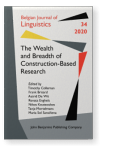Grammatical categories as paradigms in Construction Grammar
This squib discusses the question whether Construction Grammar can account for the assumption of universal grammatical
categories (
Bybee, Perkins, and Pagliuca 1994) that are prone to language change, e.g. tense.
Most publications in Construction Grammar tackle individual constructions, such as the
way-construction (
Jackendoff 1990). But it remains unclear how grammatical categories as a universal phenomenon can be
described in constructionist terms. We propose that there is a way to (a) describe grammatical categories, which per definition are encoded
paradigmatically, as constructions themselves and (b) to thereby strengthen the assumption of a set of universal grammatical categories.
Article outline
- 1.Introduction
- 2.Grammatical functions and grammatical categories
- 3.What’s (in) a paradigm?
- 4.Bridging the gap: Paradigms and constructions
- 5.Conclusion
- Acknowledgements
- Notes
-
References
References (30)
References
Ackerman, Farrell, James P. Blevins, and Robert Malouf. 2009. “Parts and Wholes: Implicative Patterns in Inflectional Paradigms.” In Analogy in Grammar: Form and Acquisition, ed. by James P. Blevins, and Juliette Blevins, 54–82. Oxford: Oxford University Press. 

Blevins, James P. 2016. Word and Paradigm Morphology. Oxford: Oxford University Press. 

Boas, Hans C. 2014. “Zur Architektur einer konstruktionsbasierten Grammatik des Deutschen.” In Grammatik als Netzwerk von Konstruktionen. Sprachwissen im Fokus der Konstruktionsgrammatik, ed. by Alexander Lasch, and Alexander Ziem, 37–63. Berlin: de Gruyter. 

Bühler, Karl. 1989 [1934]. Sprachtheorie: Die Darstellungsfunktion der Sprache. Stuttgart: UTB.
Bybee, Joan L., Revere D. Perkins and William Pagliuca. 1994. The Evolution of Grammar: Tense, Aspect and Modality in the Languages of the World. Chicago: University of Chicago Press.
Croft, William. 2001. Radical Construction Grammar: Syntactic Theory in Typological Perspective. Oxford: Oxford University Press. 

Diessel, Holger. 2019. The Grammar Network: How Linguistic Structure is Shaped by Language Use. New York: Cambridge University Press. 

Diewald, Gabriele. 1991. Deixis und Textsorten im Deutschen. Berlin: de Gruyter. 

Diewald, Gabriele. 2009. “Konstruktionen und Paradigmen”. Zeitschrift für germanistische Linguistik 37 (3): 445–468. 

Dryer, Matthew S., and Martin Haspelmath (eds.). 2013. The World Atlas of Language Structures Online. Leipzig: Max Planck Institute for Evolutionary Anthropology. (Available online at [URL], last accessed on 2020-08-18.)
Fried, Mirjam, and Jan-Ola Östman. 2004. “Construction Grammar: A Thumbnail Sketch”. In Construction Grammar in a Cross-Language Perspective, ed. by Jan-Ola Östman, and Mirjam Fried, 11–86. Amsterdam/Philadelphia: John Benjamins. 

Goldberg, Adele E. 1995. Constructions: A construction grammar approach to argument structure. Chicago: University of Chicago Press.
Goldberg, Adele E. 2006. Constructions at Work. The Nature of Generalization in Language. Oxford: Oxford University Press.
Hippisley, Andrew. 2016. “Network Morphology”. In The Cambridge Handbook of Morphology, ed. by Andrew Hippisley, and Gregory Stump, 482–509. Cambridge: Cambridge University Press. 

Jackendoff, Ray. 1990. Semantic Structures. Cambridge, Mass: MIT Press.
Jakobson, Roman. 1971 [1957]. “Shifters, verbal categories, and the Russian verb”. In Selected Writings: Vol. II: Word and language, ed. by Roman Jakobson, 130–147. The Hague/Paris: Mouton.
Jakobson, Roman and Krystyna Pomorska. 1982. Poesie und Grammatik: Dialoge. Frankfurt am Main: Suhrkamp.
Langacker, Ronald W. 1985. “Observations and Speculations on Subjectivity.” In Iconicity in Syntax. Proceedings of a Symposium on Iconicity in Syntax, Stanford, June 24–26, 1983, ed. by John Haiman, 109–150. Amsterdam/Philadelphia: Benjamins. 

Langacker, Ronald W. 2002. “Deixis and Subjectivity.” In Grounding: The epistemic footing of deixis and reference, ed. by Frank Brisard, 1–28. Berlin/New York: de Gruyter. 

Lehmann, Christian. 2015 [1982]. Thoughts on grammaticalization. Third edition. Language Science Press. 

Leiss, Elisabeth. 1992. Die Verbalkategorien des Deutschen: Ein Beitrag zur Theorie der sprachlichen Kategorisierung. Berlin/New York: de Gruyter. 

Nielsen, Peter Juul. 2016. Functional Structure in Morphology and the Case of Nonfinite Verbs. Leiden: Brill. 

Plank, Frans (ed.). 1991. Paradigms: The Economy of Inflection. Berlin/New York: De Gruyter Mouton. 

Politt, Katja. 2019. “Verbale Konstruktionen in grammatischen Paradigmen”. In Varianz in der konstruktionalen Schematizität, ed. by Dániel Czicza, Volodymyr Dekalo, and Gabriele Diewald, 217–236. Tübingen: Stauffenburg.
Politt, Katja. to appear. Parts and wholes – Formen und Funktionen von Paradigmen. PhD Dissertation, Leibniz Universität Hannover.
Plungian, Vladimir A. 1998. Грамматические категории, их аналоги и заместители [Grammatical categories, their analogs and alternatives]. Habilitation dissertation, Lomonosov Moscow State University.
Traugott, Elizabeth C., and Graeme Trousdale. 2013. Constructionalization and Constructional Changes. Oxford: Oxford University Press. 

Cited by (1)
Cited by one other publication
Bouso, Tamara, Marianne Hundt & Laetitia Van Driessche
2024.
A sisterhood of constructions? A structural priming approach to modelling links in the network of Objoid Constructions.
Cognitive Linguistics 35:3
► pp. 313 ff.

This list is based on CrossRef data as of 4 august 2024. Please note that it may not be complete. Sources presented here have been supplied by the respective publishers.
Any errors therein should be reported to them.
